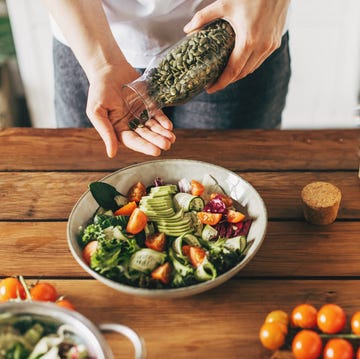Sardines made national headlines when TikTok’s “Sardine Girl Summer” kicked off this past season. The viral momentum sparked a wave of sardine-themed merch — from purses to T-shirts — items costing far more than the tinned fish itself. But the movement isn’t just about quirky accessories. Influencers are fueling the buzz with creative, delicious ways to enjoy this affordable and convenient seafood.
In the U.S. and Canada, sardine sales have risen steadily, according to Global Insights Service. A once-overlooked pantry staple is now embraced as a sustainable seafood option—and one that is packed with heart-healthy omega-3s. Globally, sales are expected to rise from $3.1 billion to $5.4 billion by 2034.
It looks like a fish that’s been a Mediterranean staple for centuries is suddenly making a splash worldwide. But are there health benefits behind this food trend? We consulted with nutritionists to find out the nutritional truth about sardines.
Sardines nutrition
It turns out sardines are a convenient, inexpensive source of quality protein. According to the USDA, one 3.75-ounce tin of sardines packed in oil contains:
- 191 calories
- 22.6g protein
- 10.5g fat
- 0g sugar
- 282mg sodium
- 351mg calcium (27% of the Daily Value — more than a cup of milk)
- 4.4mg vitamin D (22% of the Daily Value)
Are sardines healthy?
Sardines are small, oily fish that swim closer to the surface of the ocean, which means they may be less likely to carry harmful contaminants like mercury — a common concern when eating bottom-dwelling fish.
What really makes sardines shine are their health benefits. “They’re packed with omega-3 fatty acids, which are great for your heart and brain,” says Mackenzie Burgess, RDN, nutrition expert and recipe developer at Cheerful Choices. And that’s not all. “Sardines are one of the few foods naturally high in vitamin D,” she adds.
But because oily fish spoil quickly, sardines are typically canned to lock in their freshness. You'll often them packed in olive oil, brine, or tomato sauce.
How to choose sardines
“If you're looking to enjoy your omega-3 packed sardines and want to cut back on some calories, look for tinned sardines packed in water, says Toby Amidor, MS, RD, nutrition expert and author of Health Shots. “If you are watching your sodium, you can also find sardines with no salt added.”
Because tomato sauce options can amp up the sodium, those needing to cut back on salt may consider flavoring no-salt options with low-sodium tomato sauce at home. Otherwise, if you don't have other health concerns, sardines can be a healthy choice whether they're packed in oil, brine, or tomato sauce.
Best ways to eat sardines
Sure, you can eat them straight out of the tin, but you might also enjoy these tasty options recommended by dietitians:
- Layer on toast: Burgess recommends putting sardines over hummus and roasted tomatoes on top of whole grain toast. She also suggests trying them “smashed on toasted sourdough with lemon and chili flakes.”
- Serve in a hearty grain bowl. “I cook my favorite grain (like farro, brown rice) and green (collard greens, spinach, kale) and top it with sardines canned in oil along with the oil, juice of 1/2 a lemon and a few drops of hot sauce,” says Amidor.
- Mix into your pasta or salad dishes: Burgess suggests using garlic and olive oil for flavoring up these dishes. To keep this a waste-free option, Amidor uses the oil straight from the tin and makes it into a dressing, with liquids like fresh lemon juice.
- Enjoy with fluffy rice: You can borrow flavors from dishes like honey glazed salmon and use the same glaze on sardines over fluffy rice for a tasty meal, suggests Burgess.
- Mash over crackers: “I mash sardines packed in oil and use the oil too, add chopped chilis (mild or spicy), hot sauce and 1 tablespoon chopped cilantro or parsley,” says Amidor. “Mash it with the back of a fork and top on whole grain crackers.”
The bottom line
This is a case where a trendy food truly is also healthy. Sardines, once an underrated canned fish, are now making waves as a convenient protein option for people looking to try new dishes.
Stefani (she/her) is a registered dietitian, a NASM-certified personal trainer and the director of the Good Housekeeping Institute Nutrition and Fitness Lab, where she oversees all nutrition and fitness-related content, testing and evaluation. She holds a master’s degree in clinical nutrition from New York University, as well as advanced certifications as a Women's Fitness Specialist and a Behavior Change Specialist. Stefani is dedicated to providing readers with evidence-based content to encourage informed food choices and healthy living. She is an avid CrossFitter and a passionate home cook who loves spending time with her big fit Greek family.













